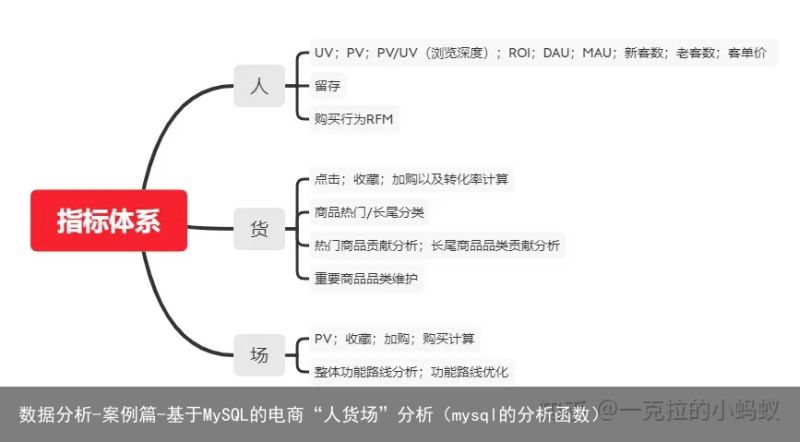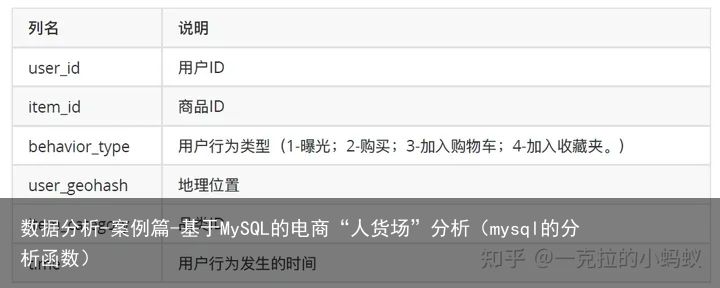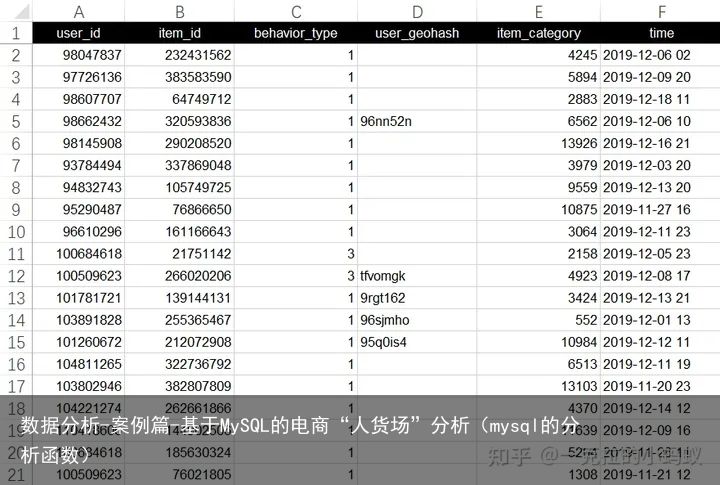新闻中心 
数据分析-案例篇-基于MySQL的电商“人货场”分析(mysql的分析函数)
本文的主要内容:
人:留存率分析;RFM模型货:商品各指标分析场:用户行为路径分析本文将利用MySQL,针对实战项目进行以上三个方面的分析。
在正式开始本文之前,我们先来了解一下什么是“人货场”:
1. 人:「人」是整个运营的核⼼。所有举动都围绕着,如何让更多的⼈有购买⾏为,让他们买的更多,买的更贵。所以对⼈的洞察是⼀切⾏为的基础。⽬前平台上的主⼒消费⼈群有哪些特征,他们对货品有哪些需求, 他们活跃在哪些场,还有哪些有消费⼒的⼈⽬前不在平台上,对这些问题的回答指向了接下来的⾏动。
2. 货:「货」就对应供给,涉及到了货品分层,哪些是红海,哪些是蓝海,如何进⾏动态调整,是要做⾃营还是平台,以满⾜消费者的需求。
3. 场:「场」就是消费者在什么场景下,以什么样的⽅式接触到了这个商品。早期的导购做的⽐较简单,⽬前的场就⽐较丰富,但也暴露了淘宝和京东在导购⽅⾯的⼀些问题。⽐如内容营销,⽬前最好的可能是微信的KOL⽣态和⼩红书,甚⾄微博,⽽不在电商⾃⼰的场。如何做⼀个全域的打通,和消费者进⾏多触点的接触,⽐如社交和电商联动,来完成销售转化,这就是腾讯和阿⾥⼀直都在讲的「全域营销」。一、项目背景
项目背景:随着电商⾏业近⼏年的迅猛发展,电⼦商务从早些年的粗放式经营,逐步转化为精细化运营。随着平台数据量的不断积累,通过数据分析挖掘消费者的潜在需求,消费偏好成为平台运营过程中的重要环节。
项目目的:
探索⽤户⾏为规律,寻找⾼价值⽤户;
分析商品特征,寻找⾼贡献商品;
分析产品功能,优化产品路径。二、使⽤“⼈货场”拆解⽅式建⽴指标体系
本文的开头部分,我们已经了解了什么是“人货场”。下面,我们针对本文具体实战项目,直接搭建指标体系,如下:

三、问题确认
1)「人」:基于RFM模型找出核⼼付费⽤户群,对这部分⽤户进⾏精准营销;
2)「场」:基于漏⽃模型的⽤户购买流程各环节分析指标,确定各个环节的转换率,便于找到需要改进的环节;
3)「货」:商品分析:找出热销商品,研究热销商品特点。
四、准备工作
1、数据读取
表结构:

建表语句:
create table o_retailers_trade_user ( user_id int (9), item_id int (9), behavior_type int (1), user_geohash varchar (14), item_category int (5), time varchar (13) );导入数据,以下是数据源:
链接:https://pan.baidu.com/s/1yLfmNDgrrKi4WncpcG5Reg 提取码:8888pan.baidu.com/s/1yLfmNDgrrKi4WncpcG5Reg前20条数据如下:

2、数据预处理
增加新列date_time(datetime),dates(char,年⽉⽇),便于后续时间维度分析
-- 增加新列date_time,dates alter table o_retailers_trade_user add column date_time datetime null; update o_retailers_trade_user set date_time =str_to_date(time,%Y-%m-%d %H) ; -- %H可以表示0-23;⽽%h表示0-12 alter table o_retailers_trade_user add column dates char(10) null; update o_retailers_trade_user set dates=date(date_time); desc o_retailers_trade_user; select * from o_retailers_trade_user limit 5;重复值处理:创建新表a,并插⼊5W条⽆重复数据
-- 创建新表a,并插⼊5W条数据。 create table temp_trade like o_retailers_trade_user; insert into temp_trade select distinct * from o_retailers_trade_user limit 50000;五、指标体系建设(SQL实现)
1、用户指标体系
1)基础指标:uv、pv、留存率(按⽇)统计
/* 需求:uv、pv、浏览深度(按⽇)统计 pv:统计behavior_type=1的记录数,需要按⽇统计(分组) uv: 统计distinct user_id 的数量,需要按⽇统计(分组)浏览深度:pv/uv */ -- pv 进⾏cout时候,如果behavior_type=1进⾏计算,如果不是,不进⾏计算 select dates, count( distinct user_id ) as uv, count( if(behavior_type=1,user_id,null)) as pv, count( if(behavior_type=1,user_id,null))/count( distinct user_id ) as pv/uv from temp_trade group by dates; -- ⽤户留存 with temp_table_trades as (select a.dates ,count(distinct b.user_id) as device_v ,count(distinct if(datediff(b.dates,a.dates)=0,b.user_id,null)) as device_v_remain0 ,count(distinct if(datediff(b.dates,a.dates)=1,b.user_id,null)) as device_v_remain1 ,count(distinct if(datediff(b.dates,a.dates)=2,b.user_id,null)) as device_v_remain2 ,count(distinct if(datediff(b.dates,a.dates)=3,b.user_id,null)) as device_v_remain3 ,count(distinct if(datediff(b.dates,a.dates)=4,b.user_id,null)) as device_v_remain4 ,count(distinct if(datediff(b.dates,a.dates)=5,b.user_id,null)) as device_v_remain5 ,count(distinct if(datediff(b.dates,a.dates)=6,b.user_id,null)) as device_v_remain6 ,count(distinct if(datediff(b.dates,a.dates)=7,b.user_id,null)) as device_v_remain7 ,count(distinct if(datediff(b.dates,a.dates)=15,b.user_id,null)) as device_v_remain15 ,count(distinct if(datediff(b.dates,a.dates)=30,b.user_id,null)) as device_v_remain30 from (select user_id ,dates from temp_trade group by user_id ,dates ) a left join ( select dates,user_id from temp_trade GROUP BY dates,user_id ) b on a.user_id = b.user_id where b.dates >= a.dates group by a.dates) select dates, device_v_remain0, concat(cast((device_v_remain1/device_v_remain0)*100 as DECIMAL(18,2)),%) as day_1%, concat(cast((device_v_remain2/device_v_remain0)*100 as DECIMAL(18,2)),%) as day_2%, concat(cast((device_v_remain3/device_v_remain0)*100 as DECIMAL(18,2)),%) as day_3%, concat(cast((device_v_remain4/device_v_remain0)*100 as DECIMAL(18,2)),%) as day_4%, concat(cast((device_v_remain5/device_v_remain0)*100 as DECIMAL(18,2)),%) as day_5%, concat(cast((device_v_remain6/device_v_remain0)*100 as DECIMAL(18,2)),%) as day_6%, concat(cast((device_v_remain7/device_v_remain0)*100 as DECIMAL(18,2)),%) as day_7%, concat(cast((device_v_remain15/device_v_remain0)*100 as DECIMAL(18,2)),%) as day_15%, concat(cast((device_v_remain30/device_v_remain0)*100 as DECIMAL(18,2)),%) as day_30% from temp_table_trades;2)RFM模型
RFM模型:R部分
-- RFM模型 -- 1.建⽴r视图,将近期购买时间提取到R临时表中 drop view if EXISTS user_recency; create view user_Recency as select user_id ,max(dates) as rec_buy_time from temp_trade where behavior_type=2 group by user_id order by rec_buy_time desc; -- 2.建⽴R等级划分视图:将客户近期购买时间进⾏等级划分,越接近2019-12-18号R越⼤; drop view if exists r_clevel; create view r_clevel as select user_id,rec_buy_time,datediff(2019-12-18,rec_buy_time)as recen_num, (case when datediff(2019-12-18,rec_buy_time)<=2 then 5 when datediff(2019-12-18,rec_buy_time)<=4 then 4 when datediff(2019-12-18,rec_buy_time)<=6 then 3 when datediff(2019-12-18,rec_buy_time)<=8 then 2 else 1 end) as r_value from user_Recency;RFM模型:F部分(⼀定时间内的消费频率)
-- 1.建⽴F视图 create view frenq_value as select user_id ,count(user_id) as buy_frenq from temp_trade where behavior_type=2 group by user_id; -- 2.建⽴F等级划分 create view f_clevel as select user_id,buy_frenq, (case when buy_frenq<=2 then 1 when buy_frenq<=4 then 2 when buy_frenq<=6 then 3 when buy_frenq<=8 then 4 else 5 end) as f_values from frenq_value; select * from f_clevel;RFM模型:M部分
因为数据集种没有金额字段,所以无M部分
整合结果:
本次数据中通过最近消费(R)和消费频率(F)建⽴RFM模型
重要⾼价值客户:指最近⼀次消费较近⽽且消费频率较⾼的客户;重要唤回客户:指最近⼀次消费较远且消费频率较⾼的客户;重要深耕客户:指最近⼀次消费较近且消费频率较低的客户;重要挽留客户:指最近⼀次消费较远且消费频率较低的客户;我们按照最近⼀次消费的均值和消费频率的均值定⾼低界限。
-- 将⽤户整合 -- 1.R平均值 SELECT avg(r_value) as r_avg FROM r_clevel; -- 2.7939 -- 2.F平均值select avg(f_values) as f_avg from f_clevel; -- 2.2606 -- 3.⽤户⼋⼤类等级划分,由于该数据没有M值,故只建⽴了4个分类 drop view if exists RFM_inall; create view RFM_inall as select a.*,b.f_values, (case when a.r_value>2.7939 and b.f_values>2.2606 then 重要⾼价值客户 when a.r_value<2.7939 and b.f_values>2.2606 then 重要唤回客户 when a.r_value>2.7939 and b.f_values<2.2606 then 重要深耕客户 when a.r_value<2.7939 and b.f_values<2.2606 then 重要挽留客户 END ) as user_class from r_clevel a, f_clevel b where a.user_id=b.user_id; SELECT count(user_id) as user_v,user_class from RFM_inall GROUP BY user_class;2、商品指标体系
1)商品的点击量 收藏量 加购量 购买次数 购买转化(该商品的所有⽤户中有购买转化的⽤户⽐)
按照商品进⾏分组统计
-- 商品的点击量 收藏量 加购量 购买次数 购买转化 select * from temp_trade; select item_id, sum(case when behavior_type=1 then 1 else 0 end) aspv, sum(case when behavior_type=4 then 1 else 0 end) asfav, sum(case when behavior_type=3 then 1 else 0 end) ascart, sum(case when behavior_type=2 then 1 else 0 end) asbuy, count(distinct case when behavior_type=2 then user_id else null end)/count(distinct user_id) as buy_rate from temp_trade group by item_id order by buy desc;对应品类的点击量 收藏量 加购量 购买次数 购买转化(该商品品类的所有⽤户中有购买转化的⽤户
⽐)
select item_category, sum(case when behavior_type=1 then 1 else 0 end) aspv, sum(case when behavior_type=4 then 1 else 0 end) asfav, sum(case when behavior_type=3 then 1 else 0 end) ascart, sum(case when behavior_type=2 then 1 else 0 end) asbuy, count(distinct case when behavior_type=2 then user_id else null end)/count(distinct user_id) as buy_rate from temp_trade group by item_category order by buy desc;3、平台指标体系
1)行为指标
点击次数 收藏次数 加购物⻋次数 购买次数 购买转化(该平台当⽇的所有⽤户中有购买转化的⽤户⽐)
-- 每⽇的分析(1-4,分别表示点击pv、购买buy、加购物⻋cart、喜欢fav) select dates,count(1) as 每⽇的总数, sum(case when behavior_type=1 then 1 else 0 end) aspv, sum(case when behavior_type=2 then 1 else 0 end) asbuy, sum(case when behavior_type=3 then 1 else 0 end) ascart, sum(case when behavior_type=4 then 1 else 0 end) asfav, count(distinct case when behavior_type=2 then user_id else null end)/count(distinct user_id) as buy_rate from temp_trade group by dates;行为路径分析
-- ⾏为路径分析-- ⾏为路径组建基础视图 drop view product_user_way; create view product_user_way as select a.* from ( select user_id, item_id, lag ( behavior_type, 4 ) over ( partition by user_id, item_id order by date_time ) lag_4, lag ( behavior_type, 3 ) over ( partition by user_id, item_id order by date_time ) lag_3, lag ( behavior_type, 2 ) over ( partition by user_id, item_id order by date_time ) lag_2, lag ( behavior_type ) over ( partition by user_id, item_id order by date_time ) lag_1, behavior_type, rank ( ) over ( partition by user_id, item_id order by date_time desc ) as rank_dn # 倒数第⼏个⾏为 from temp_trade ) a where a.rank_dn = 1 and behavior_type = 2; -- 查询该路径下有多少购买⽤户数 select concat( ifnull( lag_4, 空 ), "-", ifnull( lag_3, 空 ), "-", ifnull( lag_2, 空 ), "-", ifnull( lag_1, 空 ), "-", behavior_type ) as user_way, count( distinct user_id ) as user_count -- 该路径下购买⽤户数 from product_user_way group by concat( ifnull( lag_4, 空 ), "-", ifnull( lag_3, 空 ), "-", ifnull( lag_2, 空 ), "-", ifnull( lag_1, 空 ), "-", behavior_type );六、结论
1、用户分析
UV异常分析:每⽇UV数据中,明显异常点为双⼗⼆活动造成,该影响为已知影响。对于UV周环⽐的分析:⽇常周环⽐数据⼤多⼤于0,说明⽤户程⼀定上升趋势,其中如11⽉26⽇、12⽉2⽇、12⽉7⽇等的数据为下降数据,需要结合其他数据做进⼀步的下降原因分析。双⼗⼆活动后⽤户周环⽐会相应下降,为正常原因。猜测可能的问题有:
内部问题:产品BUG(⽹站bug)、策略问题(周年庆活动结束了)、营销问题(代⾔⼈换了)等;外部问题:竞品活动问题(其他平台⼤酬宾),政治环境问题(进⼝商品限制),舆情⼝碑问题(平台商品爆出质量问题)等;2、用户精细化运营
通过RFM模型中的⽤户最近⼀次购买时间、⽤户消费频次分析,分拆得到以下重要⽤户。
结论:
共挖掘重要客户165人。后续工作重点,需要对高价值客户(44人)做VIP服务设计,增加用户粘性同时通过设计优惠券提升客户消费;对深耕客户(44人)做广告、推送刺激,提升消费频次;对挽留客户(66人)做优惠券、签到送礼策略,增加挽留用户粘性;对唤回客户(11人)做定向广告、短信召回策略,尝试召回用户。3、商品分析
热销商品品类如下所示。
其中5027、5399品类购买转化率较其余商品品类偏低,需要结合更多数据做进⼀步解读。(可能的原因:品类⾃有特性导致⽤户购买较低,⽐如⾮必需品、奢侈品等等)4、产品功能路径分析
以下是产品的主要消费转化路径。
可以发现用户以直接购买转化为主。重新购买(第4名、第6名)和加购物车转化(第4、第6名)都有一定的排名。在所有的消费路径中,58%的用户有加入购物车的行为;但仅有0.6%的用户在加入购物车之后发生购买;购物车相关产品的后续改进会与产品经理沟通进行。本篇文章为大家提供了测试数据,出于安全考虑,百度网盘链接的有效期为30天,如果过期,可以在评论区评论哦,看到后会回复大家~
写文章不容易!写好的文章更不容易!希望大家多多点赞收藏评论喜欢!
MySQL技能篇:
数据分析方法篇:
数据分析案例篇:








![[众诚云网科技]](/uploads/allimg/20190305/c4b08346cbe8b0efae6b132139c2d72a.png)
 2023-11-19
2023-11-19 浏览次数:次
浏览次数:次 返回列表
返回列表